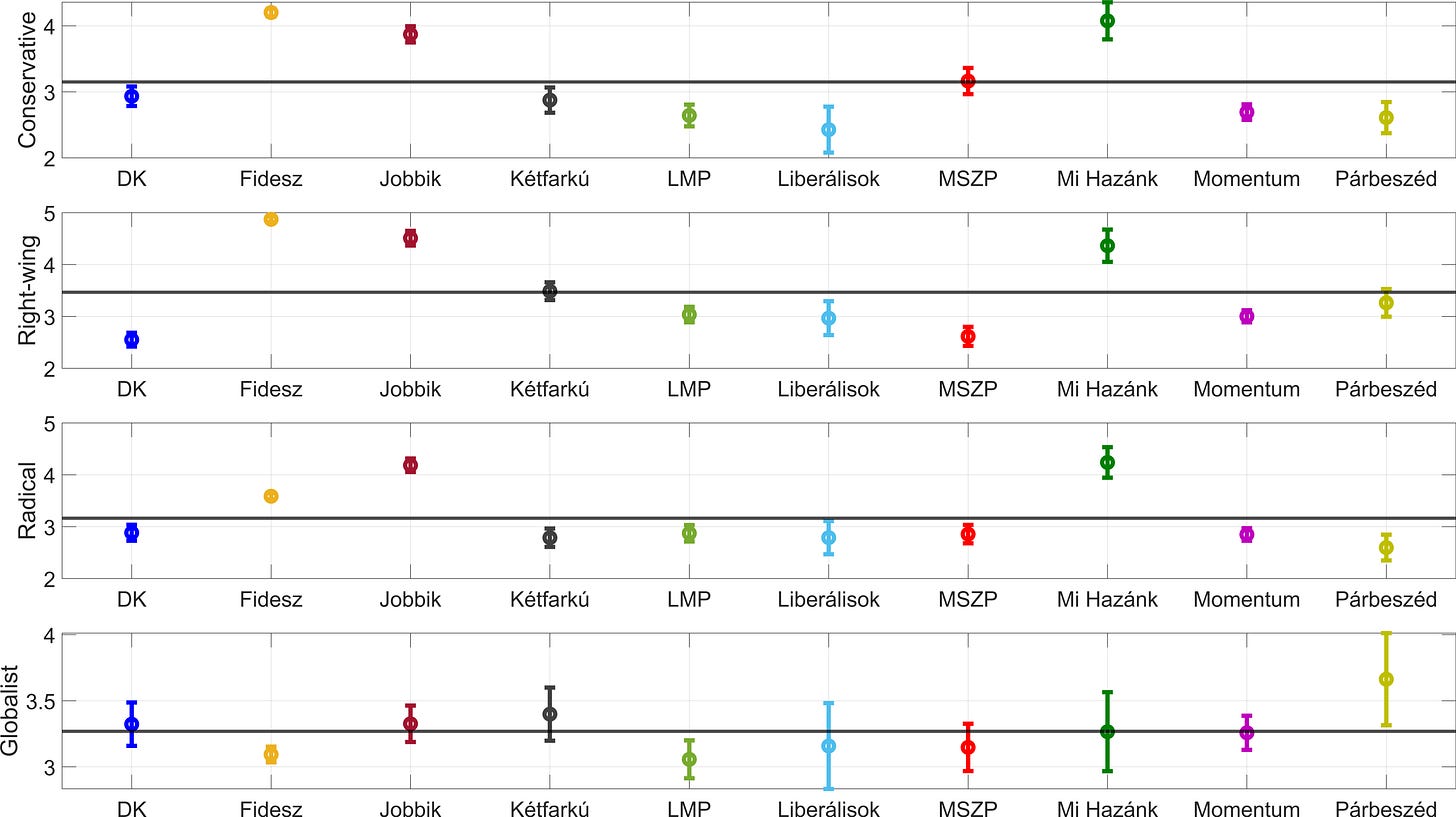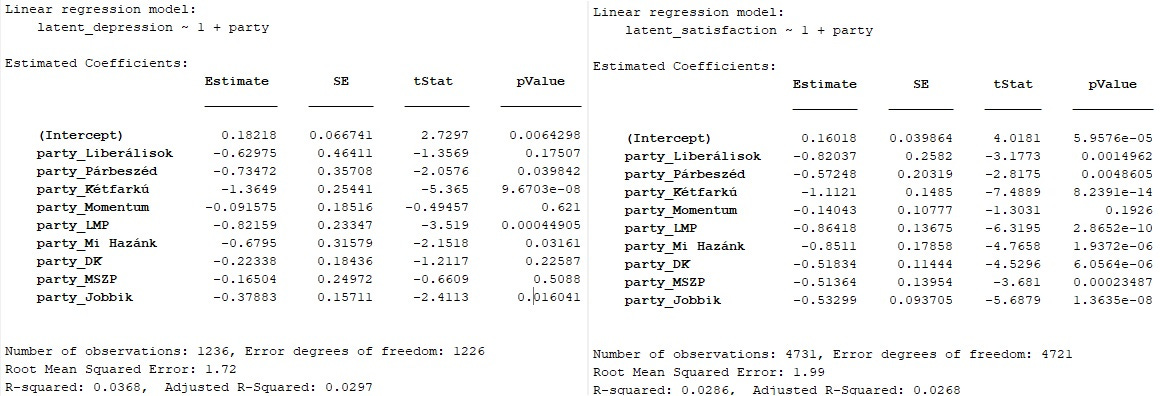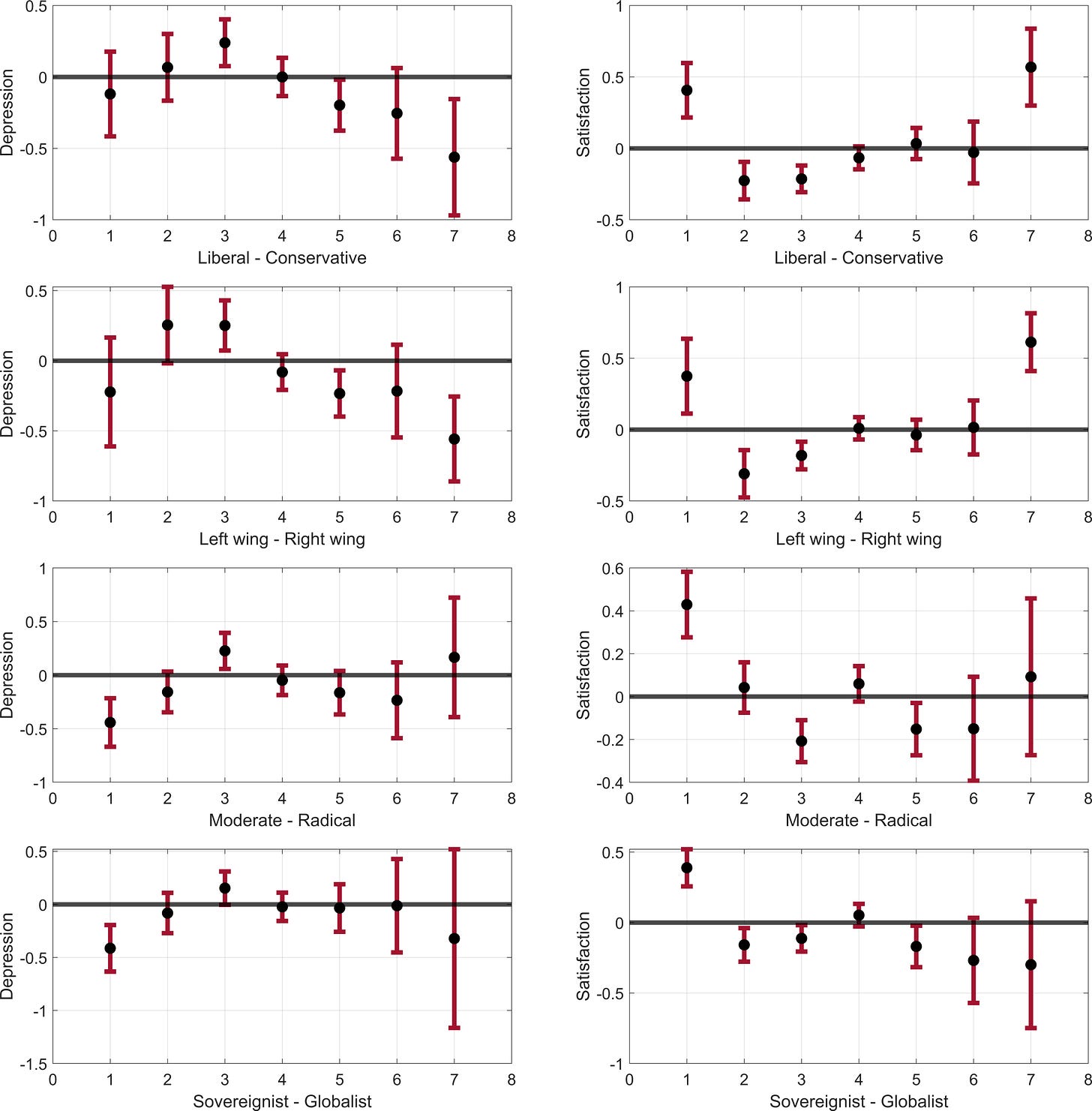In the core Western countries, politics is getting– let’s put it this way – psychiatrized. The common finding is that leftists and liberals tend to have worse mental health, although this is not true in every country.
One particular result showing worse mental health in liberals in a Pew survey, graph by Jonathan Haidt.
I always wanted to see if this replicates in my country, Hungary, so I sat down with some data to figure it out. Hungary is interesting because it is a test laboratory for a bunch of causal hypotheses about what goes on in the West in general. Hungary is internationally famous for being based, not only having a populace with little tolerance for postmodern leftist nonsense, but also a government who goes balls to the wall for these values (increasingly at the expense of other stuff a government is supposed to be doing). In Hungary, women can’t be influenced by the state media pushing woke messages because no such thing is happening. Hungarian liberals, even liberal politicians, are surprisingly normal and mostly un-woke because real woke views would be fringe and weird even in liberal circles and political suicide from a public figure. Hungarians are also terrible with foreign languages, despite being from a small country, so there is relatively little penetration of Anglophone media to young people. If international trends replicate in such an environment, it informs a whole lot of hypotheses about why stuff happens, for instance, in the United States.
For this post, I used a nationally representative survey of 8000 15–29-year-olds who were asked about a bunch of things, including political opinions. This survey, recorded in 2020, was pretty good at surveying political views, having data on preference for a specific political party as well as 7-item Likert scale self-ratings on the liberal-conservative, leftist-rightist, moderate-radical, and sovereignist-globalist continua. The last one measures a preference for either national sovereignty or rule by international bodies. The four self-rating do not correlate enough to consider them part of a single scale so it makes sense to really look at four separate ways of describing the politics of the participants.
Correlation of self-ratings of conservativism, right-wing orientation, radicalism, and support for global rather than local institutions. The scatterplots are nonsense for these Likert scales, but the trend lines and the correlation coefficients tell you what’s up.
Over 50% of participants revealed a preference for Viktor Orbán’s ruling party, Fidesz, which may show that the sample is slightly biased but not that much because he did win the closest election to the survey, the 2019 EU elections, with over 50% of the vote.
As far as mental health goes, the survey has two pretty decent scales, one about depression and another about satisfaction with life.
The depression scale is 5 items asking participants how typical it was for them (on a 1-5 Likert scale) to be happy, relaxed, active and alert, rested upon awakening, and to have days full of interesting things. Item correlations are over 0.6 or above and a single PC accounts for 70.6 of the variance so it makes sense to use PC scores to estimate a sort of latent depression. The drawback of this scale is that less than a quarter of participants (N=1994) filled it out.
The satisfaction scale asks people on a 1-5 Likert scale about how satisfied they are with romantic partners, friends, work opportunities, quality of life, financial situation, learning opportunities, the reality of life plans, future prospects and their lives overall. The “romantic partners” item stands out, but the other items show a nice positive manifold with a minimal interitem correlation of 0.31 and the first PC accounts for 60.1% of the variance, so it is a good source of a latent “satisfaction with life” score. Almost everybody had valid data (N=7971). The latent depression and satisfaction ratings correlate at 0.55 which is decent enough.
As a sort of sanity check, there are items about drinking (including a separate one about getting drunk), smoking and watching porn. They are rated on a 1-7 Likert scale indicating frequency which is not ideal but should be OK for this. One would weakly expect these things to correlate with poor mental health. They really do, the correlation is 0.12-0.21 (weakest with smoking, strongest with getting drunk).
The results
The parties
Participants could choose from 10 political parties they support1. 4962 (62%) chose an option. I first checked the self-described political alignment of supporters of various parties.
Although we have 10 parties here, they can be quite comfortably classified into just two groups: left-wing or right-wing. Left-wing parties (DK, Kétfarkú, LMP, Liberálisok, MSZP, Momentum and Párbeszéd) have voters leaning “Liberal”, “Left-wing”, and “Moderate”, while right-wing parties (Fidesz, Mi Hazánk and Jobbik) lean “Conservative”, “Right-wing” and “Radical”. Support for globalism is more fragmented. Voters of a leftist party (LMP) are the most against it, and voters of another leftist party (Párbeszéd) are most in favor, and voters of two out of the three right-wing parties at average or above-average support. Maybe respondents just didn’t understand whether this question was about rule by global corporations, which leftists don’t like, or supranational organizations, which they may like.
Mental health by political party
My main question was if voters of different parties or people with different political orientations have different levels of mental health. Means and 95% Cis are on the chart below.
For both life satisfaction and depression, Orbán voters were the best adjusted with everybody else worse off. Let’s look at linear regression results:
Because these models use PC scores with party as the single categorical predictor, you can think of the intercept as the z-score of the mean Fidesz voter and the regression coefficients as SD differences compared to this value. The joke/pirate party Kétfarkú has the saddest voters, over a full SD worse off mentally than Fidesz supporters. The other parties have voters who score about a sixth of an SD to a full SD below. This includes the other two right-wing parties, Jobbik and Mi Hazánk, who are just as bad as the leftists. Voters of Momentum, a now basically defunct party which sent two unsufferable woman MPs to the European Parliament in 2019 who openly bragged about how the European Council decided to steal Hungary’s EU funding for not being woke enough based on their advice, were the sanest of the opposition party voters. The differences are not only more significant on life satisfaction (that could be a power thing, 4x as many observations), but also greater in magnitude.
I adjusted these models for age, sex, parental education (which is a better indicator of social status than the participants’ own education, they are still very young), and self-reported social class and wealth. Not much changed – the relations are not because different parties attract voters from less or more satisfied demographics.
I was also wondering if these results are due to bias. Bias means that certain respondents would get higher or lower scores even if they have the same level of latent satisfaction or depression. For example, opposition voters might not be actually more depressed or less satisfied in a general sense: they might only say that they don’t like their job opportunities or future prospects – dissatisfaction with these things made them opposition voters after all. This is not a rhetorical question, you can answer it empirically using item response theory. I make it sound a lot simpler than it is for the sake of making the core principle understandable, but the basic idea is that if there is no bias, group differences in item scores are proportional to how well an item represents the trait to be measured. I did this using the mirt R package with this wrapper. Depression items showed no bias at all when comparing government and opposition voters. Four out of eight satisfaction items were slightly biased, but the direction of bias was random so it cancelled out at the test level. The bias caused an estimated 0.0003 SD difference between groups so it was negligible. This looks like a genuine latent trait difference.
Mental health by political alignment
What if we use self-reported political alignment instead of party affiliation? The chart below shows means and 95% CIs. I also performed linear regressions with covariates, although, as we will see, the trends are not fully linear.
Looking at the last two rows, I’m not sure if being a “radical” or a “globalist” is a good predictor of mental health. Moderates tend to be more satisfied than radicals. This is unsurprising: why would you be a radical if you are satisfied? The same can be said about those who favor local, not global administration. These trends are highly significant even in a linear model and don’t go away after controlling for covariates. Neither replicates with depression though, where effects are all over the place, borderline significant if modelled with a linear regression, and go away once I control for social status (parental education and self-reported social class/income). I think the best explanation is that if you are satisfied with your surroundings you won’t become a radical and don’t want some distant supranational body governing you, but it doesn’t have much to do with mental health.
In the first two rows, however, we see effects familiar from American samples: as we go from left-wing to right-wing and liberals to conservatives, mental health gets better. This is true for both depression and satisfaction. There is a glaring exception though: the most liberal, most left-wing respondents buck the trend, and they are second only to extreme right-wing conservatives in mental health.
What’s going on with the 96 extreme leftists and 146 extreme liberals with a score of 1? There was a lot of overlap between too: the tetrachoric correlation of extreme leftist or extreme liberal self-identification is 0.96, and the total number of respondents who are leftists or liberals is only 185.
The first thing I thought of is test bias. There was limited power to find it, but there was not much evidence for differential item functioning either at the item or test level between extreme left-liberals and others.
Next, I tried to figure out what kind of people these respondents are, so I checked the means of these left-liberals versus everybody else on some variables:
Extreme left-liberals were from more educated families and rated over half an SD more intelligent by the interviewers doing the survey (more about what this means here). Their families also had less financial difficulty and were from a higher social class, but not by much. They were more online and more interested in politics. A series of questions asked respondents how much their world view was changed by recent events. Left-liberals said that climate change, COVID, MeToo and especially BLM affected them much more than average, but migration less so. These questions are not great because “changing world view” doesn’t mean an endorsement: my world view was also drastically changed by MeToo, BLM and COVID because I hadn’t realized before how powerful mass hysterias can be, but this obviously doesn’t mean that I agreed with these movements. Left-liberals were less afraid of climate change though and only slightly more of a pandemic, they did not have better self-rated English skills, they were somewhat less likely to reside in Budapest and no more likely to watch porn. (All these other questions are based on single-item Likert scales. I wouldn’t put much faith in the porn question because 70% of the sample said they “never” watched it and another 17% that they watcher porn every few months or more rarely.)
In desperation, I even tried running a linear discriminant analysis to discover which variables separate left-liberals from the others. The results were nonsense, the variables with the highest discrimination coefficients were variables with very rare responses which happened to be given by left-liberals, such as “having a language certificate in Arabic” (N=3) or “self-identifying as a Rusin” (N=2).
I’m not sure what to make of these outliers. My best working hypothesis is that while Hungarian leftists and liberals are less sane on the whole, just like in the US, there is a reservoir of very well-adjusted smart young people who sincerely believe that modern leftist and liberal thought is correct without absorbing the degeneracy that comes with it.
I owe you an explanation what kind of parties these are. Fidesz is the now world-famous ruling part of Hungary, headed by Viktor Orbán, who has a mix of right wing identitarian-conservative views such as opposing immigration, socialist policies such as family subsidies, and pro-business libertarian ideas like defending low corporate taxes (for which Hungary was almost kicked out of the US visa waiver program) or attracting foreign investment, including from China. Liberálisok, Párbeszéd, Momentum, LMP, DK and MSZP are more or less interchangeable tiny leftist parties in a loose confederation. Leftist parties proliferate for two reasons. First, parties are divided by their relationship to former prime minister Ferenc Gyurcsány, originally from MSZP who left his post after scandals in 2009 and went on to run DK. He is viciously hated by most, including liberals, but has a die-hard core following consisting of maybe 5-10% of the electorate. Cozying up to him chases even many leftist voters away, running against him makes you lose a huge chunk of the tiny Hungarian leftist electorate. Different parties have different strategies for squaring this circle. Second, leftist parties in Hungary run a stereotypical circle of life wherein they get founded, there is a lot of enthusiasm for them being new young normal faces, and then when they get some power they do traitorous stuff like pushing for woke policies on the US State Department’s money or lobbying against Hungarian interests abroad which eventually makes them unelectable but they still linger around as long as they are financed. Párbeszéd, LMP and Momentum are like this. Kétfarkú (Two-Tailed Dog Party) is the latest, somewhat more serious iteration of this process, a joke/pirate party with a leftist electorate but more careful about doing hateful things or cozying up the other leftist parties. Jobbik used to be a right wing party but they eventually decided that they are more anti-Fidesz than anti-left so they cozied up to the leftist parties and destroyed themselves in the process. Mi Hazánk is a very radical right wing party for dumb people, basically Jobbik 15 years ago.











Also: "very well-adjusted smart young people who sincerely believe that modern leftist and liberal thought is correct without absorbing the degeneracy that comes with it" are probably future conservatives that adhere to leftist talking point for conformism.
OT: "(increasingly at the expense of other stuff a government is supposed to be doing)" like what?